
hi sibley : building surfboards, 1935
| home | catalogue | history | references | appendix |
 |
surfresearch.com.au
hi sibley : building surfboards, 1935 |
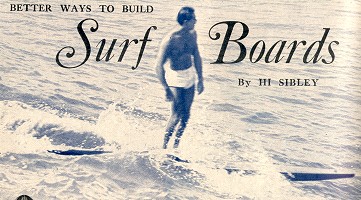
At the California beaches there are
schoolboys who easily rival the best Hawaiian experts in the thrilling
sport of surf-board riding.
That is partly because of the superior
surf boards they use - light, buoyant, and beautifully finished.
With the aid of the accompanying drawings,
any amateur woodworker can build equally good surf boards.
These designs are of the type used
at the Newport Harbor (Calif.) Union High School, where construction of
surf boards is a specialty.
Two of the plans are for large boards,
which may be paddled far from shore and used in deep water; a third design
is for a smaller and simpler board of the tobbgan type; and the fourth
is a child's paddle board.
The balsa-wood surf board show in Fig.
1 is so light that it can be carried about easily, and it has exceptional
buoyancy in the water.
Since balsa has no great strength in
itself, the board is reinforced
| Fig. 1
Balsa wood Surfboard reenforced with redwood. The construction is shown at right 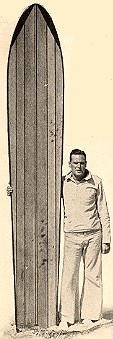 |
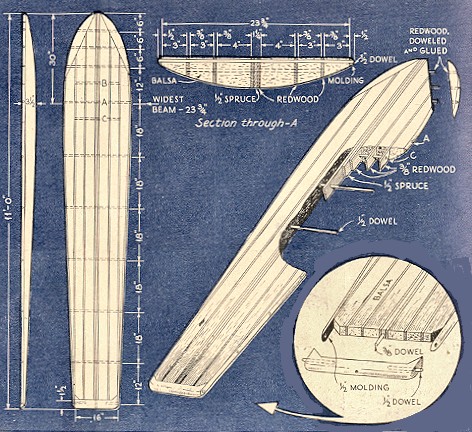 |
with redwood longerons and a central
backbone of spruce sandwiched between two pieces of redwood.
There are no nails or screws,the sections
being securely held together by dowels and casein glue.
The first step is to make the backbone.
It is a 1/2 by 3 1/2 in. strip of spruce
glued between two 3/8 in. redwood strips of the same width.
On each side of the backbone, glue
balsa timbers, 3 1/2 by 4 in. by 10 ft. 11 in.
Continue to add strips of redwood and
timbers of balsa, as indicated in the cross-section drawing. Two dowels,
marked B and C, should be inserted before the two outer pieces
of balsa are put on. Their centers are located 1 1/2 in. from the top.
When the assembly is completed, shape
the built-up plank by cutting the outline as illustrated in the plan drawing.
Allow about 1/4 in. all around for
trimming to exact size.
Before doing the trimming, however,
plane the bottom to a taper, fore and aft, from the widest beam, which
is 30 in. from the nose.
After the board has been planed and
sandpapered, glue the curved sections on the nose, and add the stern piece,
which should be of redwood.
When the glue has set, bore holes for
the dowels and insert them.
Note that the centers of all except
the two previously mentioned are located about 3/4 in. from the top.
The 1/2 in., half-round molding should
be neatly fitted, and the finish will be greatly improved if
redwood plugs are set in over the ends
of the dowels.
If waterproof casein glue has been used
liberally in all joints so that water will not seep into the porous balsa,
give the entire board four or five coats of spar ...
(Continued on page 91)
|
Laminated pine- and-redwood construction
|
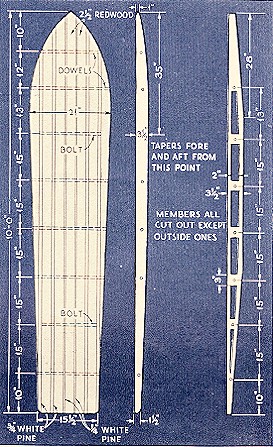 |
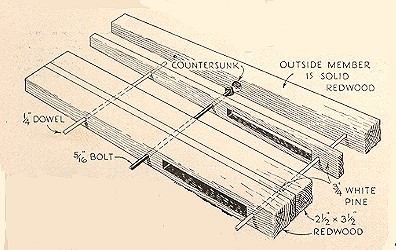 |
Fig. 2.
How to make a laminated surf board of redwood and white pine. To reduce the weight, all the strips except those on the outside are cut away as shown. A finished board appears in the photo at left above, together with two sections. The method of assembly is indicated at the left |
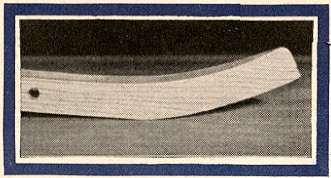 |
Fig. 3.
The forward end of one section of a toboggan-type board. All the drawings are given below |
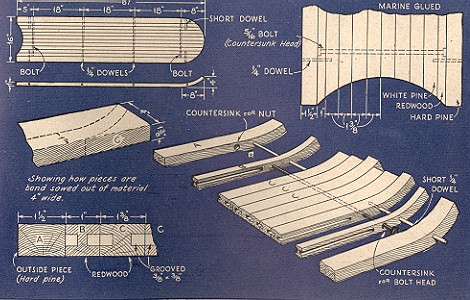
|
Pat Waldron, of the Newport Harbor (Calif.) Union High School with a partially completed toboggan surf board, made as shown at the left |
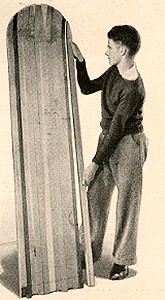 |
Continued from page 57.
varnish, rubbing well with steel wool after each one except the last.
Bear in mind that this type of board is not expected to take punishment on rocky shores or on gravel, because the balsa is easily dented.
The laminated redwood-and-pine board
shown in Fig. 2 is similar in appearance, although it differs some-what
in construction, having air cells cut in the solid wood.
It is put together with 1/4 in. dowels
and two 5/16 -in. bolts with countersunk heads and nuts, as illustrated.
Casein glue is used between the joints.
Care must be taken when planing the
assembled unit that you do not cut through into the air cells. This board
should be varnished in the natural wood.
Apply about four coats, and rub the
first three, when dry, with steel wool.
The curved-head or toboggan type of
board is illustrated in Figs. 3 and 4.
This is adapted to ordinary surf in
shallow waters, but is not intended to be paddled far from shore, as may
be safely done with the others.
It is a favorite with concessionaires
at public beaches.
As will be noted in the drawings, the
fore ends of the pieces, one of which is shown in Fig. 3, are not bent,
but are cut from straight stock.
As the two outer pieces are 11/2 in.
wide, they obviously must be band-sawed from stock that thick, and 4 in.
wide.
All of the ten inner pieces are grooved,
as shown, to reduce the weight.
Dowels, casein glue, and two bolts
are used in the assembly.
This type of board also looks best
if finished in the natural wood with spar varnish.
The child's paddle board, Fig. 5, is
made from a single piece of white pine or redwood.
It should be 3/4 or 1 in. thick.
Two or three 3/8-in. dowels or 1/4-in.
brass rods will lessen the danger of splitting.
This type of board lends itself to
striking decorations, and it is a good idea to paint an unusual pattern
with bright colors, as suggested in Fig. 6.
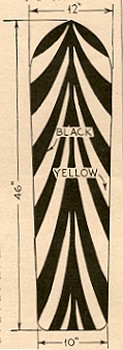 |
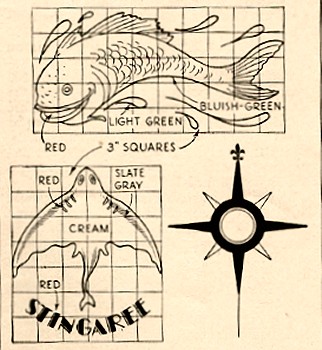
Fig. 6. Designs for decorating surfboards |
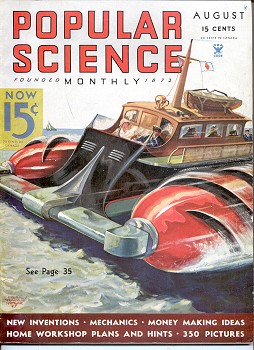 |
Popular Science August 1935 Vol 127 No. 2, pages 56, 57 and 91. |

| home | catalogue | history | references | appendix |